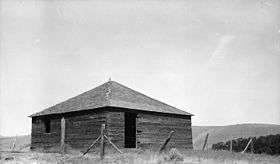Fort Simcoe
Fort Simcoe was a United States Army fort erected in south-central Washington Territory to house troops sent to keep watch over local Indian tribes. The site and remaining buildings are preserved as Fort Simcoe Historical State Park, located eight miles (13 km) west of modern White Swan, Washington, in the foothills of the Cascade Mountains.[3]
| Fort Simcoe Historical State Park | |
|---|---|
Commandant's House | |
 Location in the state of Washington | |
| Location | Yakima, Washington, United States |
| Coordinates | 46°20′34″N 120°50′13″W |
| Area | 200 acres (81 ha) |
| Elevation | 1,401 ft (427 m)[1] |
| Established | 1856-1859[2] |
| Operator | Washington State Parks and Recreation Commission |
| Website | Fort Simcoe State Park |
Fort Simcoe State Park | |
 Fort Simcoe blockhouse, ca. 1930s (HABS archives) | |
| Location | Yakima County, SW of Yakima on SR-220 |
| Nearest city | Yakima, Washington |
| Built | 1856 |
| Architect | Robert Seldon Garnett; Louis Scholl |
| Architectural style | Gothic Revival |
| NRHP reference No. | 74001994 |
| Added to NRHP | June 27, 1974 |
History
The site was a school for tribes of Indigenous peoples of the Americas from areas all around the present state of Washington. Prior to 1850, the site was used as a school where Native American children taken from their families were forced to cease practicing traditional customs and speak English, a specific practice in ethnocide. Punishment for non-compliant children included imprisonment in a small jail.
The fort was built in the late 1850s in an old oak grove watered by natural springs by future Civil War general Robert S. Garnett. The fort was in use for three years. The park was established in 1956.
The fort was built in the middle of the Yakima Valley and the Yakama Tribe's traditional fishing areas.[4] This prime location allowed soldiers of the new commander to keep an eye out for visitors to the tribe and basically keep an eye on the tribe. The relations of the White soldiers and tribes can serve as a dark time in US government relations. Fort Simcoe can be labeled as a program of an act of cultural genocide.[5] Fort Simcoe is viewed this way because the U.S. government decided to merge 14 different tribes and to teach them American culture. The tribes were to learn famous Americans and given Christian/American names.[5] In 1922, the U.S. government decided to move the Indian agency from Fort Simcoe to Toppenish which triggered extreme emotions of past feelings of relocations for generations of the original tribes.[6] The location of the fort also provided easy trading routes established by waterway or railroad. Seeing that the fort is United States government property, a certain architect designed and constructed the fort, Louis Scholl.[7] Fort Simcoe is similar to the design of Fort Dalles where there are blockhouses at each corners but no stockade allowing barracks to define the fortification.[7] James Harvey Wilbur and Captain Frederick Dent took of the challenge of creating a road passage to Fort Simcoe. They said, "the fort's location also fits perfectly with the army strategic goal to carve out a road system that connected California with Washington Territory".[8] This quote demonstrates the determination to get to Fort Simcoe and how naturally it can be easy to get there but it is all based around strategic movements by the government.
Park and museum
Fort Simcoe Historical State Park is a 200-acre (0.81 km2), day-use heritage park on the Yakama Indian Reservation. The park is primarily an interpretive effort, telling the story of mid-19th-century army life and providing insights into the lifeways of local Native Americans. Five original buildings are still standing at the fort: the commander's house, three captain's houses, and a blockhouse. Various other buildings have been recreated to appear original. Houses are filled with period furnishings. The park was placed on the National Register of Historic Places in 1974.
The interpretive center, the original commander's house and two officer's buildings with period furnishings open to the public from April through September on Wednesday through Sunday. The original blockhouse and other recreated fort buildings are not open to the public. Special re-enactments and living history events are held during the year, as well as other special events.
References
- "Fort Simcoe State Park". Geographic Names Information System. United States Geological Survey.
- Douglas M. Whisman, Historic Preservation Specialist (May 21, 1971). "National Register of Historic Places Registration Form: Fort Simcoe State Park". National Park Service. Retrieved February 10, 2016.
- "Fort Simcoe Historical State Park". Washington State Parks and Recreation Commission. Retrieved January 10, 2020.
- Becker, Paula; Wilma, David. "United States establishes Fort Simcoe at the foot of the Simcoe Mountains on August 8, 1856". Retrieved 30 May 2019.
- Meyers, Donald W. "United States establishes Fort Simcoe at the foot of the Simcoe Mountains on August 8, 1856". Yakima Herald (Feb 17, 2019). Retrieved 30 May 2019.
- Anderson, Talea. "I Want My Agency Moved Back..., My Dear White Sisters": Discourses on Yakama Reservation Reform". Pacific Northwest Quarterly. 104:4 (Fall 2013): 178–187. Retrieved 30 May 2019.
- "Fort Simcoe". Fort Wiki. Retrieved 30 May 2019.
- McKenzie, Michael (Fall 2002). "LESSONS FROM AN OLD ROAD: Frederick Dent's Route from Fort Dalles to Fort Simcoe" (PDF). Columbia: The Magazine of Northwest History. 16 (3). Retrieved 30 May 2019.
External links
- Fort Simcoe Historical State Park Washington State Parks and Recreation Commission
- Fort Simcoe Historical State Park Map Washington State Parks and Recreation Commission
- Photos of Fort Simcoe Library of Congress Historic American Buildings Survey/Historic American Engineering Record/Historic American Landscapes Survey